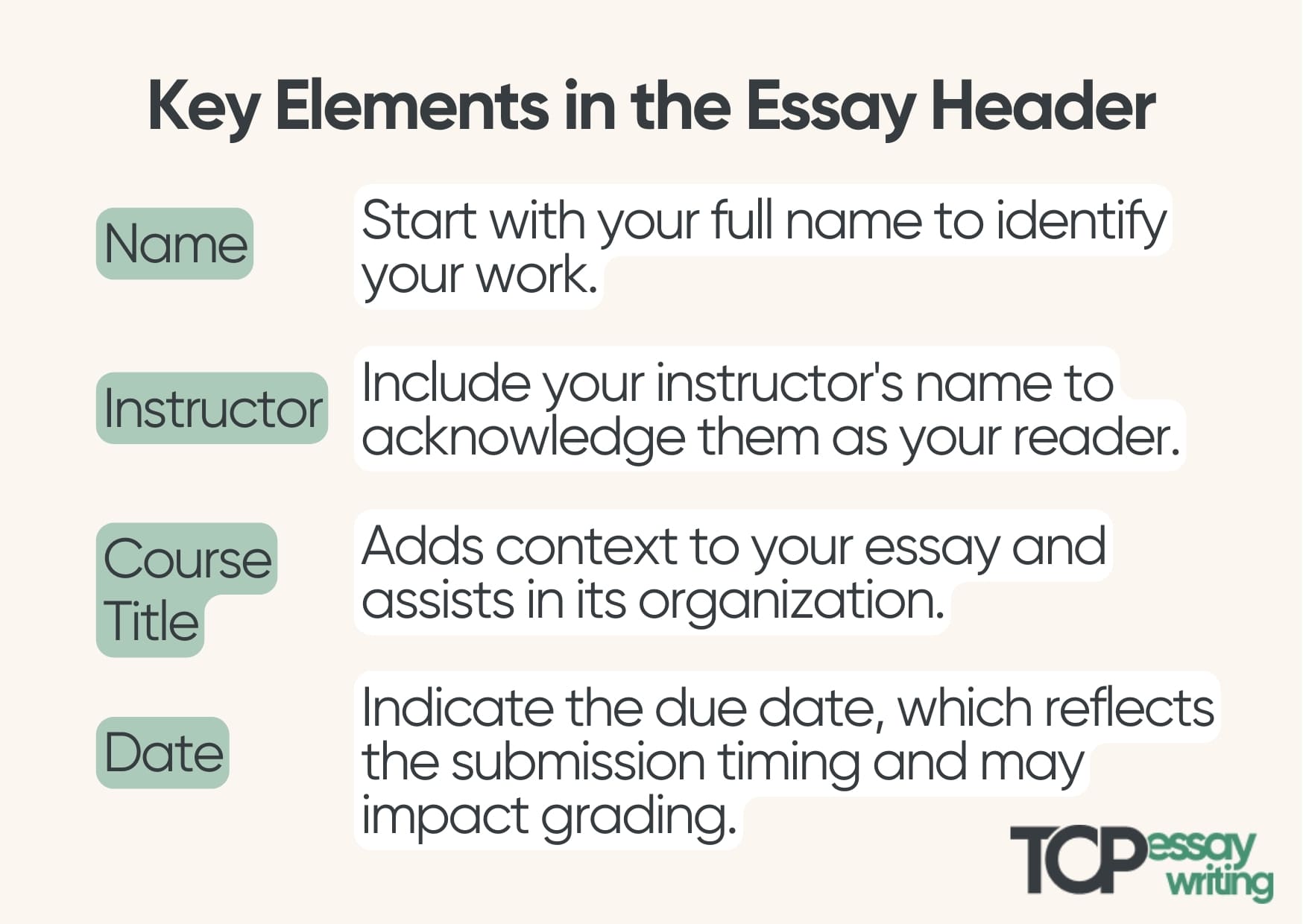Top Special Offer! Check discount
Get 13% off your first order - useTopStart13discount code now!
How to Format the Top of Your Essay: Practical Guide
Every academic essay that you write will begin with its header, which is why many students look up rules on how to format the top of an essay. The header is not a mere formality: it is the first thing you do to demonstrate your attention to detail and respect for academic standards. A well-formatted header will help your readers get familiar with your work, and it will also give a good, professional first impression to the person reading your essay.
Although it is a small part of your essay, the header is important. If you get it wrong, your essay will look messy. And it won’t have complied with academic formatting requirements. To ensure that you put your best foot forward, it is important to format the top of your essay correctly. Let’s take a look at how to do it!
What to Put at the Top of an Essay
If you are wondering what should go at the top of your essay, chances are that you’re working in MLA format. MLA format is the most common format used in the humanities and liberal arts. Understanding what should go at the top of your essay can help you comply with academic requirements. It also helps to make your work look more professional.
What is MLA Format?
MLA is among the top of paper format styles. When you format your papers and cite sources in MLA format, a style that is widely used in the liberal arts and humanities, you follow certain rules regarding the layout of your pages, the way your text should look on those pages, and how you credit the sources you’ve used. In an MLA-formatted paper, you provide certain information at the top of your essay, following guidelines that let your readers know your essay is set up correctly right from the start. If you need help with paper formatting and think, “Can I get the best essay writing help online?”, you’re in luck. Many online writing services can polish your paper and make it look presentable. They always know the latest formatting rules, so you won’t need to get into the details of each formatting style.
MLA Format Top Of Paper Key Elements
Header as an organizational tool. While writing your essay, the header should never be an afterthought. Instead, it should contain important information in a clear and professional way. Here’s what you need to put at the top of your essay, especially if you’re working within MLA format:
- Name: Start with your full name to show the reader who has written the essay. This serves to distinguish your essay from others.
- Instructor: Putting your instructor’s name at the top of an essay in your submission is a nice touch, and shows respect for the person who will read your essay.
- Course Title: This provides the context for your writing and can help a professor file your essay in your records.
- Date: This simple piece of information is critical because it tells us when you submitted your work and might be one of the factors that a grader takes into account. If you are wondering what date do you put on an essay, the answer is simple - due date.

Without these elements, however, your essay risks looking unfinished and unprofessional, with all information just floating loosely between the margins without the benefit of an academic skeleton to hold it in place. Below are all the elements you need to make your essay look complete. Before we continue, note that all the important identifying information appears at the top of the first page and is vertically aligned to the left margin so that it can be seen at a glance.
Top Of Essay Format Rules: Alignment, Spacing, Font
Following the format of an MLA essay involves paying attention to things like alignment, spacing, and font type, all of which contribute to the document’s readability and formality:
- Alignment: All of your text in an MLA essay should be left-aligned. The MLA format top left corner rule makes your paper look clean and professional. It helps your reader keep track of your essay’s organization.
- Spacing: MLA format calls for double spacing throughout the entire essay, including your header and any works cited pages. This spacing makes your essay more readable and gives your teacher or professor room to make comments or corrections.
- Font: Times New Roman, 12-point size. This isn’t just for aesthetic reasons but also because a formal, readable font ensures that your essay is accessible to those with visual impairments.
These are not arbitrary conventions for what goes at the top of an essay. Such rules make reading and grading easier for everyone who sees your submission. By following these guidelines, you ensure that your essay is seen as serious and taken on its merits rather than its presentation. Also, following these rules will ensure that you won’t lose any points when your paper is graded due to formatting issues.
How To Format Top Of Essay If I Have a Different Style?
Sometimes, your academic field will demand a different format, and if you’re not working in MLA format, you might be writing in APA, Chicago, or Harvard styles. These formats all have different rules about how to format your essay’s title page and header. These matters are important for citation and presentation:
APA Style
Title Page: The title page is a cover page that introduces your essay. It’s an answer to the query about how and where to put your name on an essay. The title page of an APA paper should include the title, your name, the name of your institution, the course you are taking, the instructor of that course, and the date. It should all be centered on both the vertical and horizontal axes of the page. If you need help with APA formatting, contact the professional APA paper writer on our website.
Running head: The title is shortened and left-justified (up to 50 characters), followed by the page number (right-justified). This running head is critical for establishing a ‘stair-step’ identifier that aids in page location and reference. It’s among the first things you add to your page when you think about what to write at the top of an essay.
Chicago Style
Notes-Bibliography System: The Notes-Bibliography System is common in literature and history. It uses footnotes or endnotes, as well as a bibliography. You will center ‘Title’, ‘Author’, and ‘Course Information’ on the title page.
Author-Date: This system is common in the sciences and uses parenthetical author-date citations and a reference list. The title page is similar to the Notes-Bibliography system, but the in-text references emphasize the publication date and author’s last name.
Harvard Style
Harvard-style title page must include the following elements, which should be centered instead of being at the top left corner of the essay: the title of your paper, your name, the University, the Name of the course, and the Date of submission.
Further Page Headers: These should be a short title on the left and the page number on the right, mirroring the simplicity and clarity of the title page layout.
The specifics of each style exist to help you communicate with your peers and the larger academic community. By following the rules, you make sure that your academic writing is well-organized, readable, and respectful of the conventions of your discipline. It’s also a good practice to look up paper samples formatted in the style you need so that you can see for yourself what to put in the top left corner of an essay. Thankfully, you find many essay examples for free online. This will help you see the visual representation of all the formatting requirements.
Conclusion
Attention to format signals that you are serious about the field, about your discipline, and about the standards that your colleagues and your teachers expect you to meet. If your text looks like it was written by a professional, then it will be taken as if it was written by one. You will have set a model of clarity and organization that will make your essay all the more readable.
Always check the latest style guides - they will tell you how to put your name on a college paper, what alignment to use, how to cite sources, etc. They are updated periodically to reflect changing norms and standards in academic writing. Also, always ask your instructor to clarify any specific formatting requirements for your assignments.



